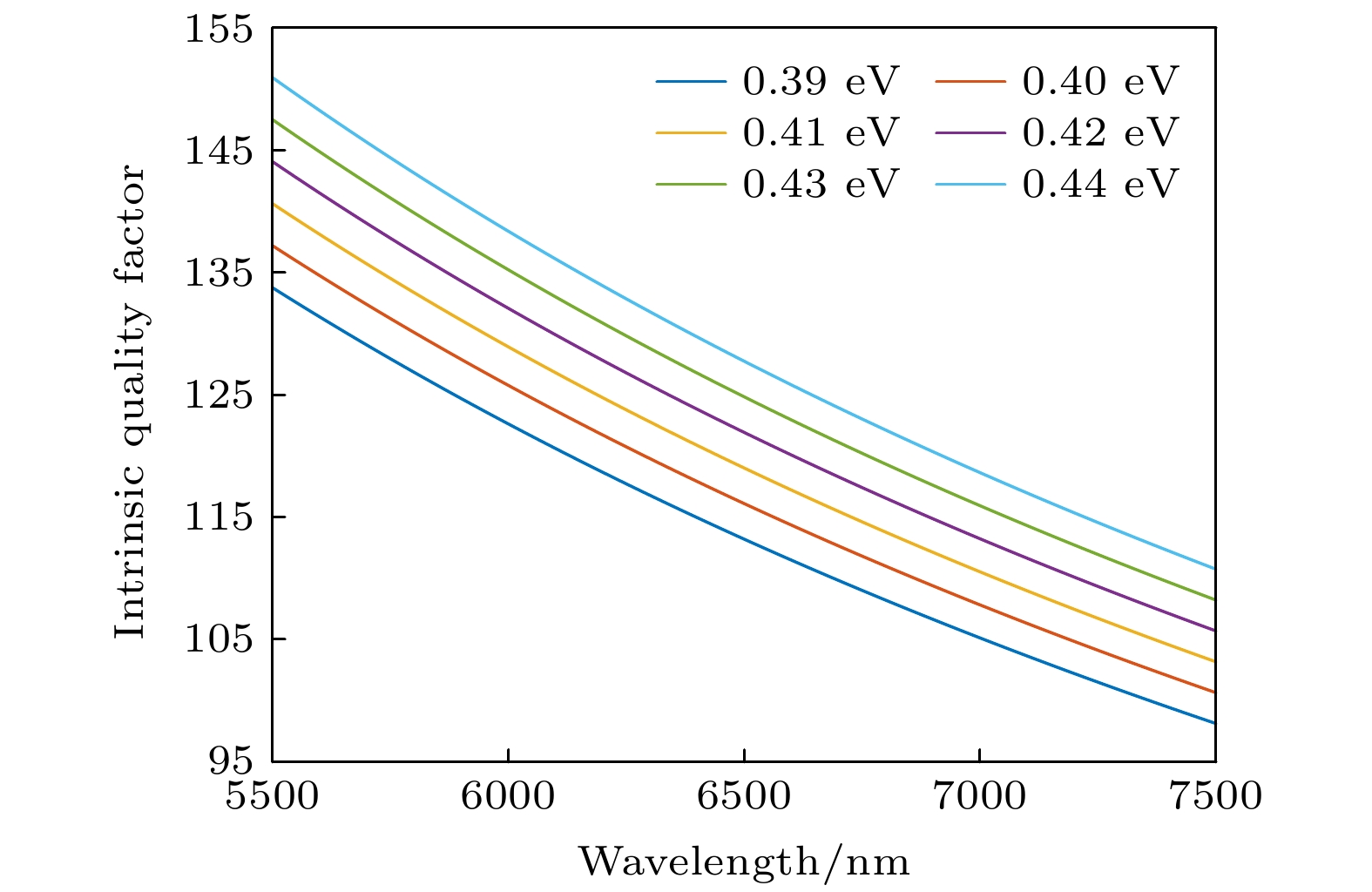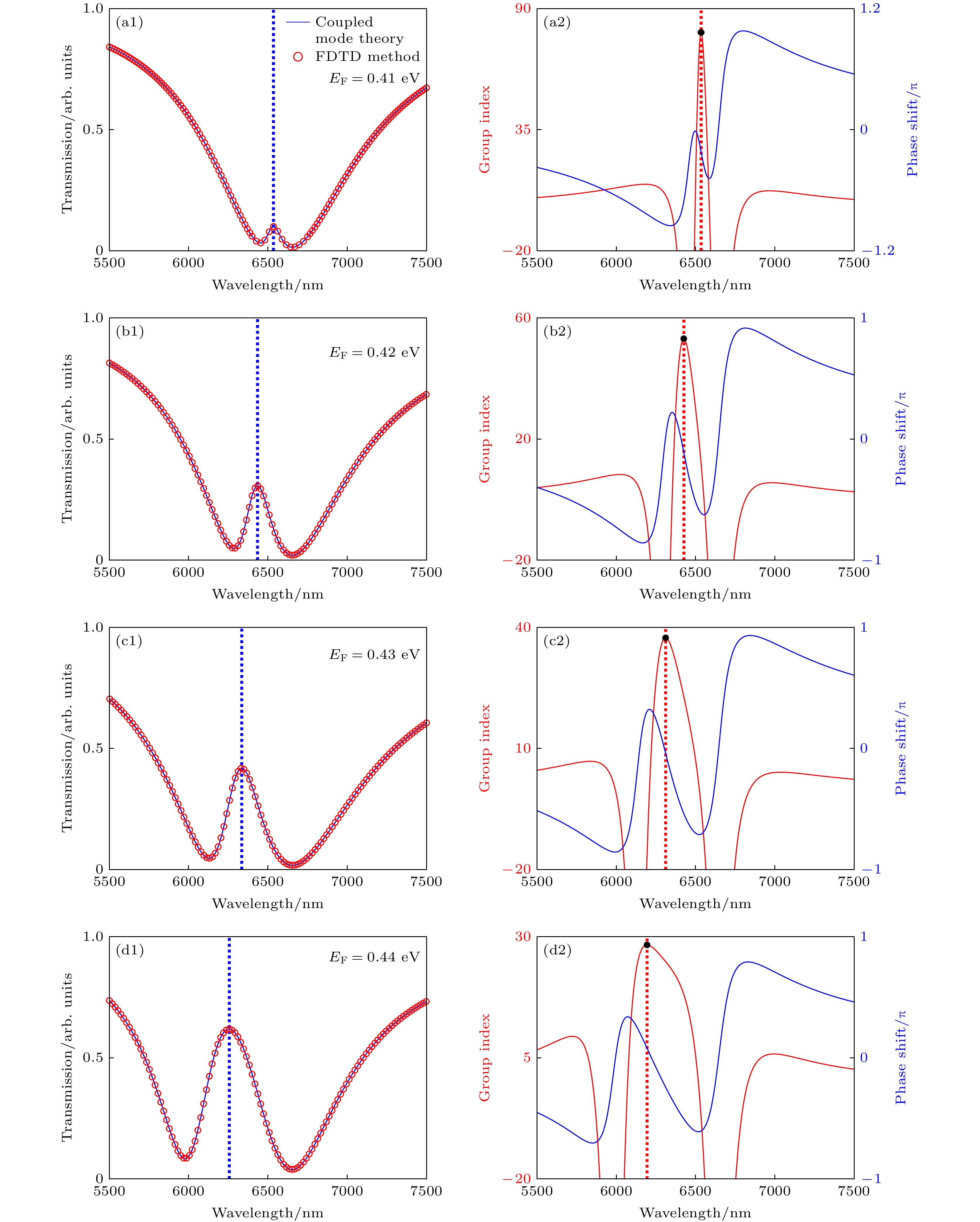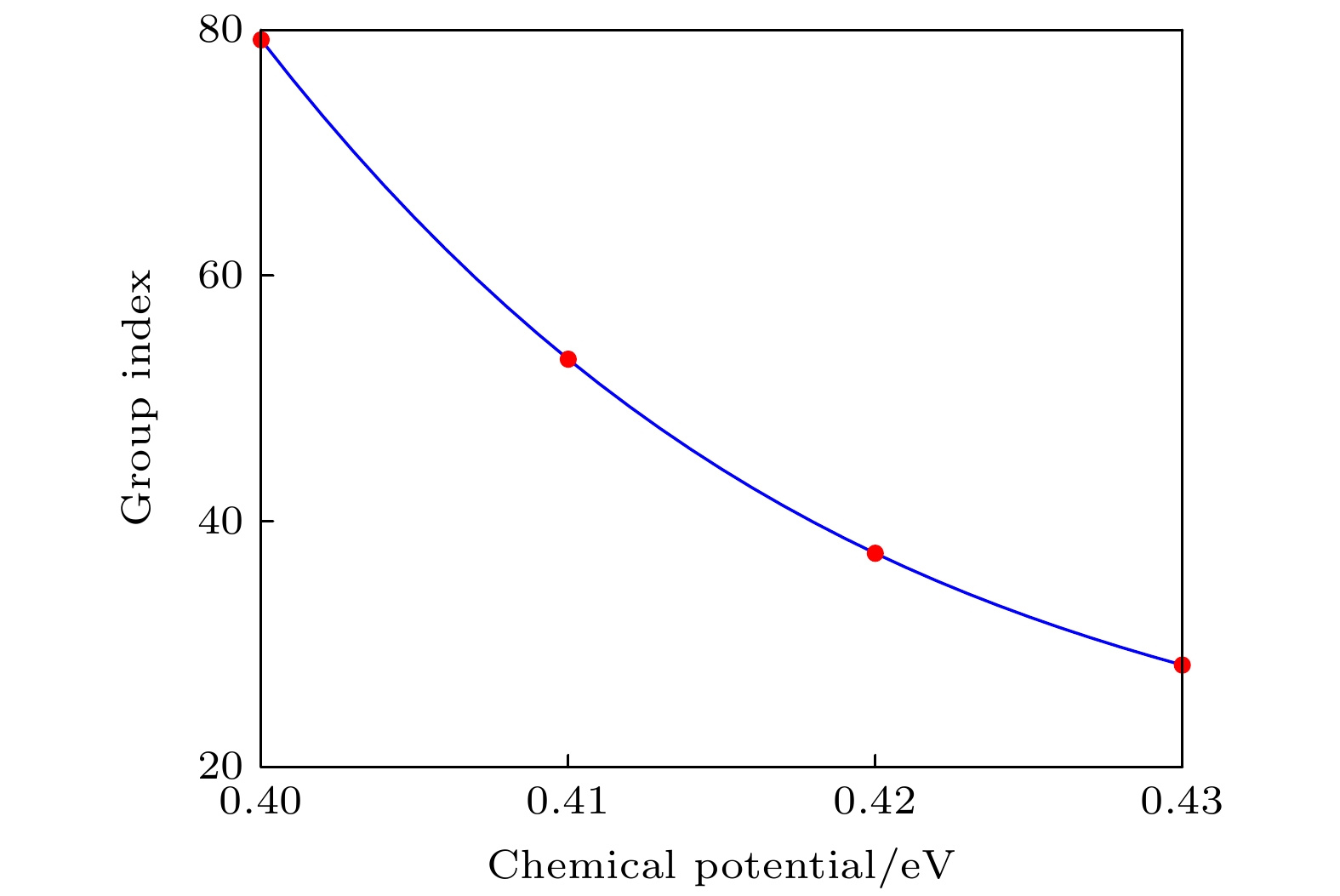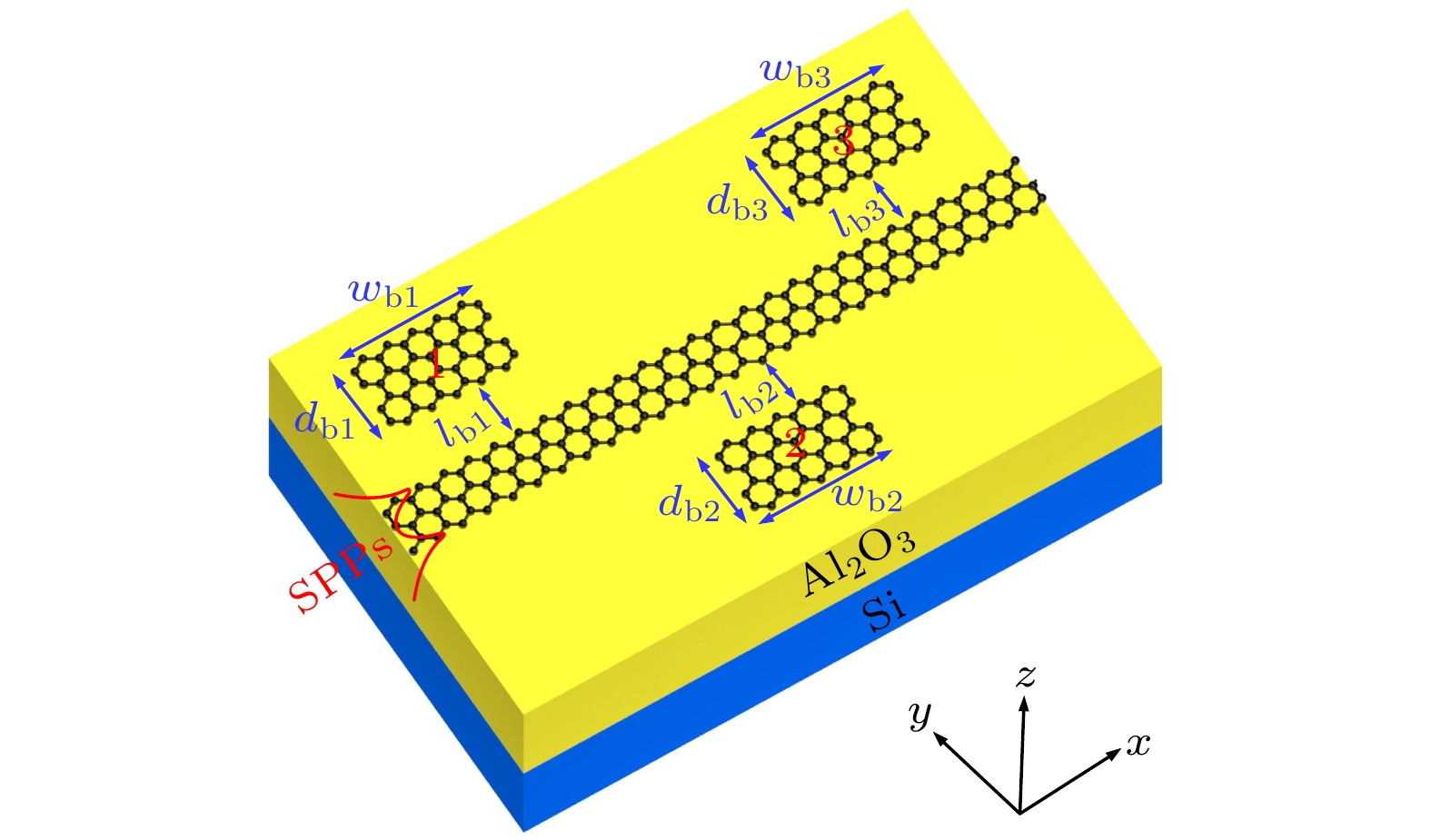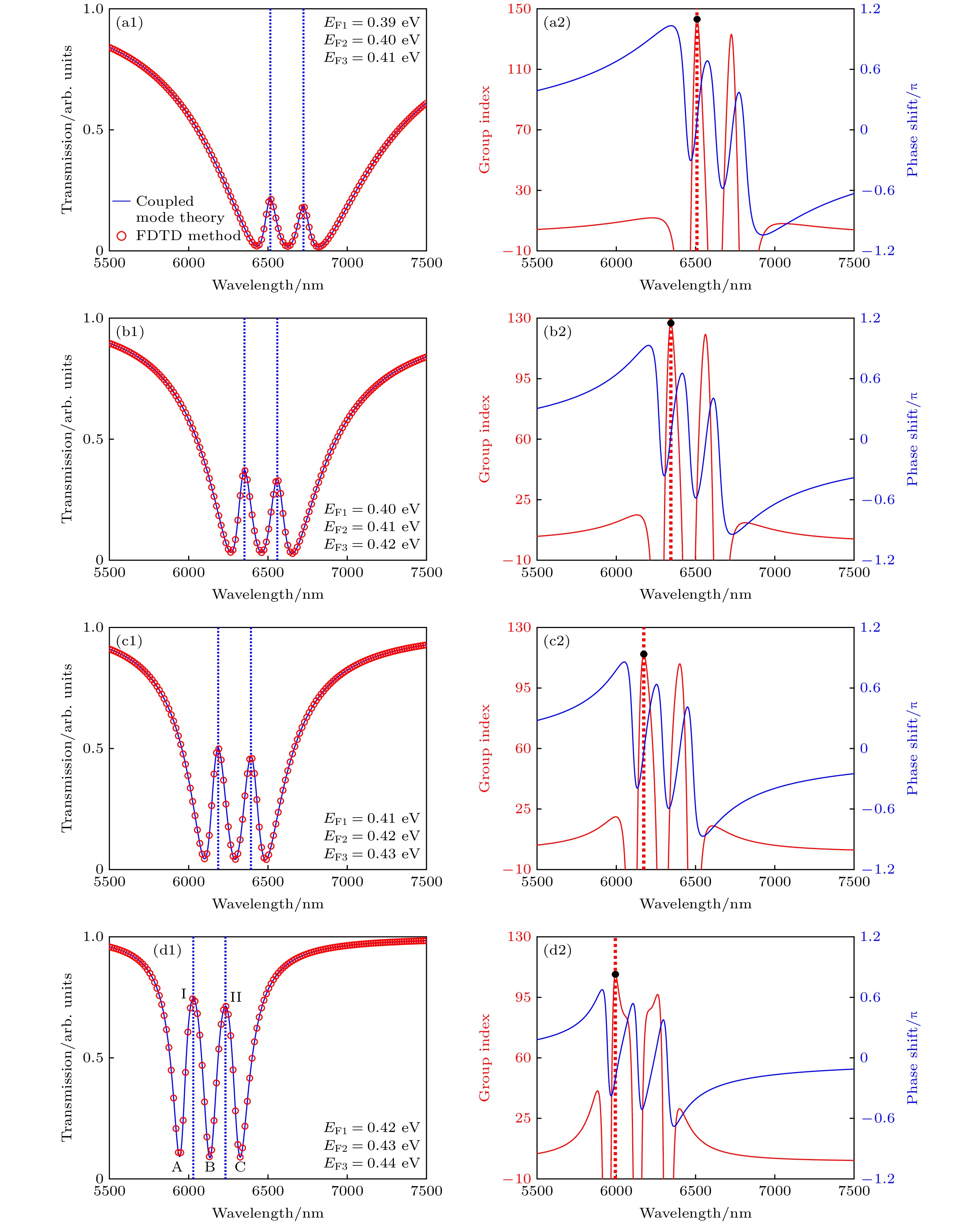-
为了减小器件尺寸、实现超快速响应和动态可调谐, 研究了基于石墨烯纳米条波导边耦合矩形腔的单波段和双波段的等离子体诱导透明(PIT)效应, 通过耦合模式理论和时域有限差分法从数值计算和模拟仿真两方面分析了模型的慢光特性. 通过调节石墨烯矩形腔的化学势, 同时实现了单波段、双波段PIT模型的谐振波长和透射峰值的可调谐性. 当石墨烯的化学势增加时, 各个波段PIT窗口的谐振波长逐渐减小, 发生蓝移. 此外, 通过动态调谐石墨烯矩形腔的谐振波长, 当石墨烯矩形腔的化学势为0.41—0.44 eV时, 单PIT系统的群折射率控制在79.2—28.3之间, 可调谐带宽为477 nm; 当石墨烯矩形腔1, 2, 3的化学势分别为0.39—0.42 eV, 0.40—0.43 eV, 0.41—0.44 eV时, 双PIT系统的群折射率控制在143.2—108.6之间. 并且, 整个系统的尺寸小于0.5 μm2. 研究结果对于超快速、超紧凑型和动态可调谐的光传感、光滤波、慢光和光存储器件的设计和制作具有一定的参考意义.In order to reduce the size of the device and realize the ultrafast response time and dynamic tunableness, the single-band and dual-band plasmon induced transparency (PIT) effect are investigated based on graphene nanoribbon waveguide side-coupled rectangle cavity. The slow light properties of the model are analyzed numerically and theoretically by coupled mode theory and finite difference time domain method. With controlling the chemical potential of the graphene rectangle cavity, the tunability of the resonant wavelength and the transmission peak can be achieved simultaneously in single-band and dual-band PIT model. As the chemical potential of graphene increases, the resonant wavelength of each transmission window of PIT effect decreases gradually and presents the blue shift. In addition, through dynamically tuning the resonant wavelength of the graphene rectangle cavity, when the chemical potential of the graphene rectangle cavity increases from 0.41 to 0.44 eV, the group index of single PIT system is controlled to be between 79.2 and 28.3, and the tunable bandwidth is 477 nm. Moreover, the group index of dual PIT system is controlled to be between 143.2 and 108.6 when the chemical potentials of graphene rectangle cavities 1, 2, and 3 are 0.39–0.42 eV, 0.40–0.43 eV, and 0.41–0.44 eV, respectively. The size of the entire PIT structure is <0.5 μm2. The research results here in this work are of reference significance in designing and fabricating the optical sensors, optical filters, slow light and light storage devices with ultrafast, ultracompact and dynamic tunableness.
-
Keywords:
- plasmon induced transparency /
- graphene /
- finite difference time domain /
- rectangle cavities
[1] Gao E D, Liu Z M, Li H J, Xu H, Zhang Z B, Luo X, Xiong C X, Liu C, Zhang B H, Zhou F Q 2019 Opt. Express 27 13884
 Google Scholar
Google Scholar
[2] Liu J H, Yu Y F, Zhang Z M 2019 Opt. Express 27 15382
 Google Scholar
Google Scholar
[3] Ziemkiewicz D, Slowik K, Zielinska-Raczynska S 2018 Opt. Lett. 43 490
 Google Scholar
Google Scholar
[4] Neubert T J, Wehrhold M, Kaya N S, Balasubramanian K 2020 Nanotechnology 31 405201
 Google Scholar
Google Scholar
[5] Li H J, Wang L L, Sun B, Huang Z R, Zhai X 2016 Plasmonics 11 87
 Google Scholar
Google Scholar
[6] Zhang T, Zhou J Z, Dai J, Dai Y T, Han X, Li J Q, Yin F F, Zhou Y, Xu K 2018 J. Phys. D:Appl. Phys. 51 055103
 Google Scholar
Google Scholar
[7] Liu Y C, Li B B, Xiao Y F 2017 Nanophotonics 6 789
 Google Scholar
Google Scholar
[8] Wang B Y, Zeng Q D, Xiao S Y, Xu C, Xiong L B, Lv H, Du J, Yu H Q 2017 J. Phys. D:Appl. Phys. 50 455107
 Google Scholar
Google Scholar
[9] Xiong C X, Li H J, Xu H, Zhao M Z, Zhang B H, Liu C, Wu K 2019 Opt. Express 27 17718
 Google Scholar
Google Scholar
[10] Han X, Wang T, Li X M, Zhu Y J 2015 J. Phys. D:Appl. Phys. 48 235102
 Google Scholar
Google Scholar
[11] Xu H, Xiong C X, Chen Z Q, Zheng M F, Zhao M Z, Zhang B H, Li H J 2018 J. Opt. Soc. Am. B 35 1463
 Google Scholar
Google Scholar
[12] Liu Z M, Zhang X 2020 New J. Phys. 22 083006
 Google Scholar
Google Scholar
[13] Huang H L, Xia H, Guo Z B, Li H J, Xie D 2018 Opt. Commun. 424 163
 Google Scholar
Google Scholar
[14] Zhang S, Genov D A, Wang Y, Liu M, Zhang X 2008 Phys. Rev. Lett. 101 047401
 Google Scholar
Google Scholar
[15] Zhang B H, Li H J, Xu H, Zhao M Z, Xiong C X, Liu C, Wu K 2019 Opt. Express 27 3598
 Google Scholar
Google Scholar
[16] Cen H F, Wang F Q, Liang R S, Wei Z C, Meng H Y, Jiang L H, Dong H G, Qin S J, Wang L, Wang C L 2018 Opt. Commun. 420 78
 Google Scholar
Google Scholar
[17] Qiu P P, Qiu W B, Lin Z L, Chen H B, Ren J B, Wang J X, Kan Q, Pan J Q 2017 Nanoscale Res. Lett. 12 374
 Google Scholar
Google Scholar
[18] Sun C, Si J N, Dong Z W, Deng X X 2016 Opt. Express 24 11466
 Google Scholar
Google Scholar
[19] Fan C Z, Jia Y L, Ren P W, Jia W 2021 J. Phys. D: Appl. Phys. 54 035107
 Google Scholar
Google Scholar
[20] Li J B, Xiao X J, Tan Y, Guo Q Q, Liang S, Xiao S, Zhong H H, He M D, Liu L H, Luo J H, Chen L Q 2020 Opt. Express 28 3136
 Google Scholar
Google Scholar
[21] Zhang T, Liu Q, Dan Y H, Yu S, Han X, Dai J, Xu K 2020 Opt. Express 28 18899
 Google Scholar
Google Scholar
[22] Wang B Y, Zhu Y H, Zhang J, Zeng Q D, Du J, Wang T, Yu H Q 2020 Chin. Phys. B 29 377
[23] Karampitsos N, Kyrginas D, Couris S 2020 Opt. Lett. 45 1814
 Google Scholar
Google Scholar
[24] Baudisch M, Marini A, Cox J D, Zhu T, Silva F, Teichmann S, Massicotte M, Koppens F, Levitov L S, Abajo F J G, Biegert J 2018 Nat. Commun. 9 1018
 Google Scholar
Google Scholar
[25] Xiao B G, Zhu J F, Xiao L H 2020 Appl. Opt. 59 6041
 Google Scholar
Google Scholar
[26] Xu H, Zhao M Z, Zheng M F, Xiong C X, Zhang B H, Peng Y Y, Li H J 2019 J. Phys. D:Appl. Phys. 52 025104
 Google Scholar
Google Scholar
[27] 胡宝晶, 黄铭, 黎鹏, 杨晶晶 2020 物理学报 69 174201
 Google Scholar
Google Scholar
Hu B J, Huang M, Li P, Yang J J 2020 Acta Phys. Sin. 69 174201
 Google Scholar
Google Scholar
[28] Zhan S, Li H, Cao G, He Z, Li B, Yang H 2014 J. Phys. D:Appl. Phys. 47 205101
 Google Scholar
Google Scholar
[29] Chen Z, Chen H, Yin J, Zhang R, Jile H, Xu D, Yi Z, Zhou Z, Cai S, Yan P 2021 Diamond Relat. Mater. 116 108393
 Google Scholar
Google Scholar
[30] Chen Z, Chen H, Jile H, Xu D, Yi Z, Lei Y, Chen X, Zhou Z, Cai S, Li G 2021 Diamond Relat. Mater. 115 108374
 Google Scholar
Google Scholar
[31] Jiang L, Yuan C, Li Z, Su J, Yi Z, Yao W, Wu P, Liu Z, Cheng S, Pan M 2021 Diamond Relat. Mater. 111 108227
 Google Scholar
Google Scholar
-
表 1 PIT峰值波长处, 不同石墨烯矩形腔化学势、泵浦光强下的PIT系统最大群折射率
Table 1. The maximum group index of the PIT system under different chemical potentials of graphene rectangle cavities and pump light intensity at the peak wavelength of PIT.
调谐方式 相关参数 PIT系统最大群折射率 石墨烯化学势 EF1 = 0.39 eV, EF2 = 0.40 eV, EF3 = 0.41 eV 143.2 EF1 = 0.40 eV, EF2 = 0.41 eV, EF3 = 0.42 eV 127.3 EF1 = 0.41 eV, EF2 = 0.42 eV, EF3 = 0.43 eV 116.2 EF1 = 0.42 eV, EF2 = 0.43 eV, EF3 = 0.44 eV 108.6 泵浦光强 I = 11.7 MW·cm–2 14.5 [10] -
[1] Gao E D, Liu Z M, Li H J, Xu H, Zhang Z B, Luo X, Xiong C X, Liu C, Zhang B H, Zhou F Q 2019 Opt. Express 27 13884
 Google Scholar
Google Scholar
[2] Liu J H, Yu Y F, Zhang Z M 2019 Opt. Express 27 15382
 Google Scholar
Google Scholar
[3] Ziemkiewicz D, Slowik K, Zielinska-Raczynska S 2018 Opt. Lett. 43 490
 Google Scholar
Google Scholar
[4] Neubert T J, Wehrhold M, Kaya N S, Balasubramanian K 2020 Nanotechnology 31 405201
 Google Scholar
Google Scholar
[5] Li H J, Wang L L, Sun B, Huang Z R, Zhai X 2016 Plasmonics 11 87
 Google Scholar
Google Scholar
[6] Zhang T, Zhou J Z, Dai J, Dai Y T, Han X, Li J Q, Yin F F, Zhou Y, Xu K 2018 J. Phys. D:Appl. Phys. 51 055103
 Google Scholar
Google Scholar
[7] Liu Y C, Li B B, Xiao Y F 2017 Nanophotonics 6 789
 Google Scholar
Google Scholar
[8] Wang B Y, Zeng Q D, Xiao S Y, Xu C, Xiong L B, Lv H, Du J, Yu H Q 2017 J. Phys. D:Appl. Phys. 50 455107
 Google Scholar
Google Scholar
[9] Xiong C X, Li H J, Xu H, Zhao M Z, Zhang B H, Liu C, Wu K 2019 Opt. Express 27 17718
 Google Scholar
Google Scholar
[10] Han X, Wang T, Li X M, Zhu Y J 2015 J. Phys. D:Appl. Phys. 48 235102
 Google Scholar
Google Scholar
[11] Xu H, Xiong C X, Chen Z Q, Zheng M F, Zhao M Z, Zhang B H, Li H J 2018 J. Opt. Soc. Am. B 35 1463
 Google Scholar
Google Scholar
[12] Liu Z M, Zhang X 2020 New J. Phys. 22 083006
 Google Scholar
Google Scholar
[13] Huang H L, Xia H, Guo Z B, Li H J, Xie D 2018 Opt. Commun. 424 163
 Google Scholar
Google Scholar
[14] Zhang S, Genov D A, Wang Y, Liu M, Zhang X 2008 Phys. Rev. Lett. 101 047401
 Google Scholar
Google Scholar
[15] Zhang B H, Li H J, Xu H, Zhao M Z, Xiong C X, Liu C, Wu K 2019 Opt. Express 27 3598
 Google Scholar
Google Scholar
[16] Cen H F, Wang F Q, Liang R S, Wei Z C, Meng H Y, Jiang L H, Dong H G, Qin S J, Wang L, Wang C L 2018 Opt. Commun. 420 78
 Google Scholar
Google Scholar
[17] Qiu P P, Qiu W B, Lin Z L, Chen H B, Ren J B, Wang J X, Kan Q, Pan J Q 2017 Nanoscale Res. Lett. 12 374
 Google Scholar
Google Scholar
[18] Sun C, Si J N, Dong Z W, Deng X X 2016 Opt. Express 24 11466
 Google Scholar
Google Scholar
[19] Fan C Z, Jia Y L, Ren P W, Jia W 2021 J. Phys. D: Appl. Phys. 54 035107
 Google Scholar
Google Scholar
[20] Li J B, Xiao X J, Tan Y, Guo Q Q, Liang S, Xiao S, Zhong H H, He M D, Liu L H, Luo J H, Chen L Q 2020 Opt. Express 28 3136
 Google Scholar
Google Scholar
[21] Zhang T, Liu Q, Dan Y H, Yu S, Han X, Dai J, Xu K 2020 Opt. Express 28 18899
 Google Scholar
Google Scholar
[22] Wang B Y, Zhu Y H, Zhang J, Zeng Q D, Du J, Wang T, Yu H Q 2020 Chin. Phys. B 29 377
[23] Karampitsos N, Kyrginas D, Couris S 2020 Opt. Lett. 45 1814
 Google Scholar
Google Scholar
[24] Baudisch M, Marini A, Cox J D, Zhu T, Silva F, Teichmann S, Massicotte M, Koppens F, Levitov L S, Abajo F J G, Biegert J 2018 Nat. Commun. 9 1018
 Google Scholar
Google Scholar
[25] Xiao B G, Zhu J F, Xiao L H 2020 Appl. Opt. 59 6041
 Google Scholar
Google Scholar
[26] Xu H, Zhao M Z, Zheng M F, Xiong C X, Zhang B H, Peng Y Y, Li H J 2019 J. Phys. D:Appl. Phys. 52 025104
 Google Scholar
Google Scholar
[27] 胡宝晶, 黄铭, 黎鹏, 杨晶晶 2020 物理学报 69 174201
 Google Scholar
Google Scholar
Hu B J, Huang M, Li P, Yang J J 2020 Acta Phys. Sin. 69 174201
 Google Scholar
Google Scholar
[28] Zhan S, Li H, Cao G, He Z, Li B, Yang H 2014 J. Phys. D:Appl. Phys. 47 205101
 Google Scholar
Google Scholar
[29] Chen Z, Chen H, Yin J, Zhang R, Jile H, Xu D, Yi Z, Zhou Z, Cai S, Yan P 2021 Diamond Relat. Mater. 116 108393
 Google Scholar
Google Scholar
[30] Chen Z, Chen H, Jile H, Xu D, Yi Z, Lei Y, Chen X, Zhou Z, Cai S, Li G 2021 Diamond Relat. Mater. 115 108374
 Google Scholar
Google Scholar
[31] Jiang L, Yuan C, Li Z, Su J, Yi Z, Yao W, Wu P, Liu Z, Cheng S, Pan M 2021 Diamond Relat. Mater. 111 108227
 Google Scholar
Google Scholar
计量
- 文章访问数: 7208
- PDF下载量: 126
- 被引次数: 0













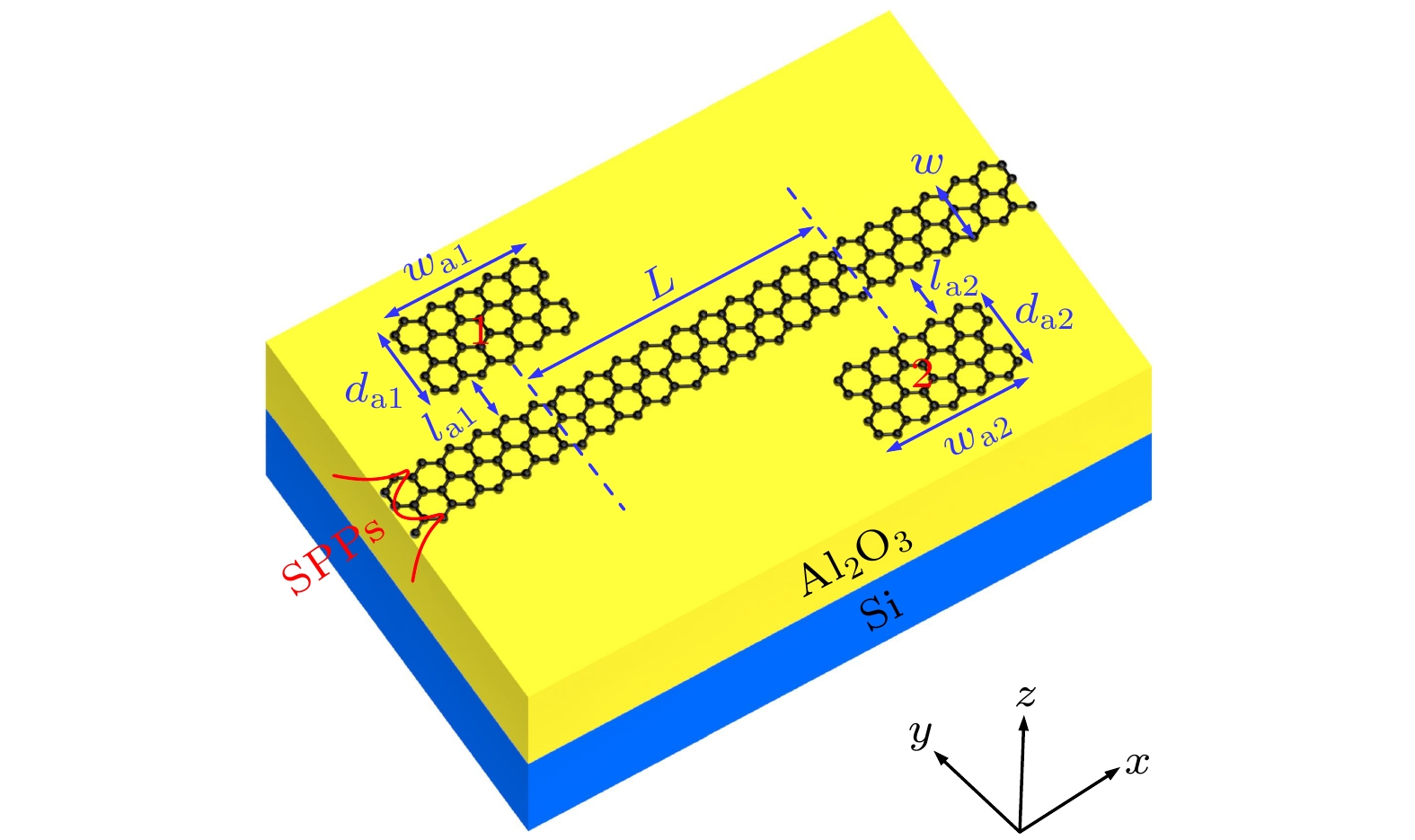
 下载:
下载:
